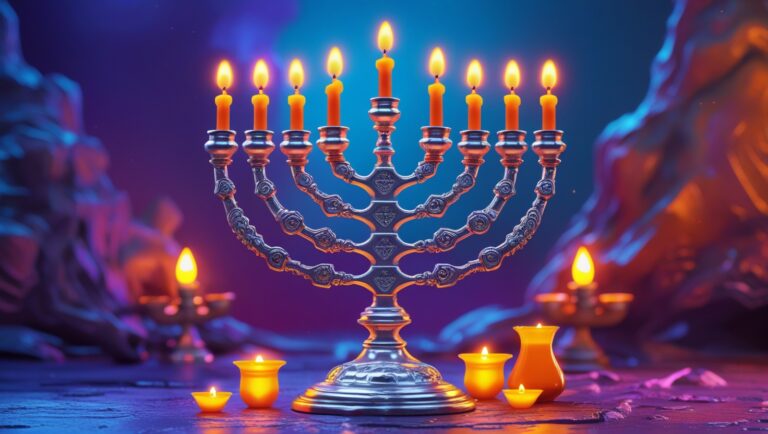The Beit Haknesset, known more widely as the synagogue or Shul, stands as a vital heartbeat in the rhythm of Jewish life, which a Kedusha (holiness) of its own.
The holy R’ Elazar Abuchatzeira, the Baba Elazar used to prostrate while trembling before entering the Beit HaKnesset. It is a revered environment where we literally meet the Shekhina, a Mikdash (a place where Chokhmah is revealed) and where prayers rise more easily, Torah is delivered to groups, and is reserved for special events.
The essence of the Beit Haknesset is rooted in a hightened kedusha, guarded by a series of Halachot (Jewish laws) that underscore the respect and decorum required within its walls.
In this article, we will be exploring some of the established laws and the deeper Kabbalistic secrets woven into the Beit Haknesset.
Historical background on the Beit Haknesset
The concept of the Beit Haknesset took root during a pivotal era in Jewish history: the Babylonian Exile of the 6th century BCE. Stripped of their Temple and the familiar rituals it hosted, the Jewish people sought new ways to maintain their Emunah and collective identity in a foreign land.
It was no walk in the park, and it was in this time of yearning and adaptation that the first semblances of communal prayer spaces emerged, laying the groundwork for what would eventually become the synagogue.
By the period of the Second Temple, synagogues had become integral to Jewish communal life, serving as places where Torah was read and prayers were recited. While the Temple in Jerusalem remained the spiritual epicenter, synagogues functioned as supplementary spaces for worship and study, enabling the Jewish diaspora to uphold a sense of connection to our religious practices and to each other.
The significance of the Beit Haknesset expanded even further after the Second Temple’s destruction in 70 CE. With the Temple’s physical presence lost, synagogues took on an even greater role, preserving the continuity of Jewish communal prayer and becoming hubs for spiritual resilience. It was not just “some building where you pray”.
Either way, the Batei Knessiot were no longer just auxiliary spaces but became vessels through which Jewish tradition, learning, and community thrived. Each Beit Haknesset, in its own right, came to be a place where Hashem met the people, and where Jews could gather to reaffirm their bond with God.
Some Halachot of the Beit HaKnesset
The Beit Haknesset is treated with a level of sanctity and respect reflective of its spiritual significance in Jewish life. Below are many of the key halachot that govern the conduct within the synagogue:
- Reverence for the Divine Presence: The Beit Haknesset is a place where the Shechinah, or divine presence, resides. Therefore, one must enter with a sense of awe and reverence. This means maintaining a respectful demeanor and refraining from any behavior that would diminish the sanctity of the space. Actions such as joking, idle chatter, or frivolous behavior are strictly forbidden. Shulchan Aruch, Orach Chaim 151:1.
- Prohibition Against Eating and Drinking: Eating and drinking in the Beit Haknesset are generally prohibited to maintain its sanctity. This halacha underscores that the synagogue is primarily a space for prayer, Torah study, and divine service, not mundane activities. Shulchan Aruch, Orach Chaim 151:1.
- The Mishnah Berurah (151:4) clarifies certain exceptions for meals related to a seudat mitzvah.
- Sleeping in the Synagogue: Sleeping in a Beit Haknesset is also generally forbidden, as it is considered disrespectful to treat the sacred space like a common resting place. However, there is an exception for an avrech (a dedicated Torah scholar) or those who spend extended periods studying and praying in the synagogue. Their dedication to Torah may necessitate brief rest periods, and this is permitted as an act of devotion rather than negligence. Shulchan Aruch, Orach Chaim 151:3.
- Appropriate Attire: One must dress modestly and respectfully when entering a Beit Haknesset. This is in line with the principle of honoring a place where God’s presence dwells. Clothing should be clean and dignified, suitable for standing before a king. Shulchan Aruch, Orach Chaim 91:5.
- Prohibition of Idle Talk: Conversations unrelated to prayer, Torah study, or communal needs are generally not permitted within the Beit Haknesset. Engaging in idle talk distracts from the sanctity of the space and interrupts the spiritual atmosphere necessary for prayer and reflection. Shulchan Aruch, Orach Chaim 151:1. The Mishnah Berurah elaborates that this applies to any type of conversation unrelated to prayer or Torah study.
- Prohibition Against Running and Unseemly Behavior: It is forbidden to run or act with undue haste within the Beit Haknesset, as this implies a lack of respect. One should walk calmly and purposefully when moving about the synagogue, reflecting the gravity of the space. Shulchan Aruch, Orach Chaim 151:7: The Mishnah Berurah (151:24) explains the importance of maintaining an atmosphere of dignity.
- Respect for the Ark (Aron HaKodesh) and Sacred Objects: The Aron HaKodesh, which houses the Torah scrolls, must be treated with great reverence. It is customary to stand when the ark is open, reflecting the deep respect for the Torah. Similarly, when handling Torah scrolls or other sacred objects, special care must be taken to avoid any behavior that would be considered disrespectful. Shulchan Aruch, Orach Chaim 147:1-2: Emphasizes the respect one must have when the Aron Kodesh is open and when handling Torah scrolls.
- Prohibition Against Using the Beit Haknesset as a Shortcut: One may not use the Beit Haknesset as a thoroughfare to pass through to another location. This halacha emphasizes that the synagogue should be treated as an end in itself, a place entered only for prayer, study, or acts of communal unity. Shulchan Aruch, Orach Chaim 151:5. The Mishnah Berurah (151:19) notes that this applies even when someone has an entrance and exit aligned for such use.
- Recitation of Blessings and Prayers: It is considered a privilege to recite blessings and prayers in the Beit Haknesset, and one should prepare mentally and spiritually before beginning. The use of proper kavanah (simple intention in this case) is essential, as the prayers recited within the synagogue ascend directly to higher spiritual realms. Shulchan Aruch, Orach Chaim 98:1. The Arizal would always respond the Amen to the Birkot HaShachar of other people who came later.
- Refraining from Spitting and Improper Gestures: Out of respect for the holy atmosphere, spitting and other inappropriate physical gestures are forbidden in the Beit Haknesset. This reflects a heightened awareness that one’s behavior should befit a space dedicated to the divine. Shulchan Aruch, Orach Chaim 151:6.
- Leaving Respectfully: When exiting the Beit Haknesset, one should leave with the same sense of reverence and mindfulness as when entering the palace of the King of Kings. Some traditions involve taking a few steps backward before turning to leave, symbolizing a reluctance to depart from the presence of holiness. While there is no explicit ruling in the Shulchan Aruch about stepping backward when exiting, this practice is based on general customs related to showing respect when leaving a holy place, akin to how one steps back at the end of the Amidah prayer (Shulchan Aruch, Orach Chaim 123:1).
Kabbalistic Insights on the Beit Haknesset
As we mentioned before, the Beit Haknesset is a microcosm of the Beit HaMikdash (Holy Temple) in Jerusalem. Just as the Temple was a conduit through which divine energy flowed into the world, the synagogue acts as a miniature version of this awesome space.
There’s a spiritual benefit to hastening oneself to go to this hallowed place as we find in the Kitvei Ari. Before leaving the house it’s important to put the hand in the Mezuza and kiss it since, when a man does so with Talit and Tefilin, 2 angels proclaim “give way to the image of the King!. The Mezuza inside the house is an aspect of Malkhut as we see from the Kavanah below from the Siddur HaRashash:
There’s also a very important task to be one of the first 10 men in the Beit HaKnesset in the morning since they “receive reward equal to all those that come after”. Though this is one of the heights of Avodat Hashem, Rav Chaim Vital writes that the Arizal was seldom among the first 10 men because he was often sick and had to take care of himself for some time before arriving.
Our tradition places great emphasis on the idea of the collective soul of the Jewish people, where the gathering of a minyan (a quorum of ten) represents the unification of individual sparks into one cohesive entity, summoning the Shekhina.
The number ten is significant as it clearly parallels the 10 Sephirot, representing completeness and the full array of divine attributes. Praying with a minyan allows Jews to transcend their personal spiritual limitations and tap into the combined power of collective prayer, which has a higher capacity to reach the divine throne. Some say that the collective prayer is combined to form one unified whole with all the best parts of each of them being used. So if I had less Kavanah in one part and another person had more, then it is counted as if his prayer was “the one used” in that particular part.
Before entering however it is very important that one should stop completely to contemplate on the fear of Hashem. He should then say the 2 following pesukim with the kavanot below which translates as: “To the House of Elohim we enter trembling” and then “And me, with your Chessed, will come to your House, prostrate to your Holy Chamber in Awe. This Kavanah, the Arizal writes, is incredibly powerful to instill the Fear of Heaven, which is one of the greatest character traits one can attain, and the beginning of true wisdom and true Avodat Hashem.
One last simple Kavanot we see below when we enter, is that the Beit HaKnesset is an aspect of Malkhut which is represented by the Miluy of Ba”n (יוד הה וו הה) which receives light from the upper 3 names of A”b, Sa”g and Ma”h, and Knesset is also 10 times the name Ba”n
It pays to repeat that we learn from the Zohar that each phase of the Shacharit prayer service represents an ascent through different spiritual worlds:
- The preliminary prayers relate to the world of Asiyah (Action), where we start by grounding ourselves.
- The Pesukei Dezimra (verses of praise) align with Yetzirah (Formation), focusing on emotional refinement.
- The Shema and its blessings correspond to Beriah (Creation), connecting to deeper intellectual awareness.
- The Amidah prayer represents Atzilut (Emanation), the closest state to divine unity, where the worshipper can almost touch the essence of Ein Sof.
This is all possible in the Beit HaKnesset, where Jews gather and can recite the Kaddish and the reading of the Torah, since they require a minyan. The Kaddish in particular acts as a bridge between each of the spiritual worlds. As an aside, the reason we don’t say Kaddish before the Amidah of Shacharit is that since we are so high up, the world of Beriyah rises of its own to Atzilut
May these insights inspire you in your Avodat Hashem and may we draw to us the sanctity of the Beit HaKnesset.







